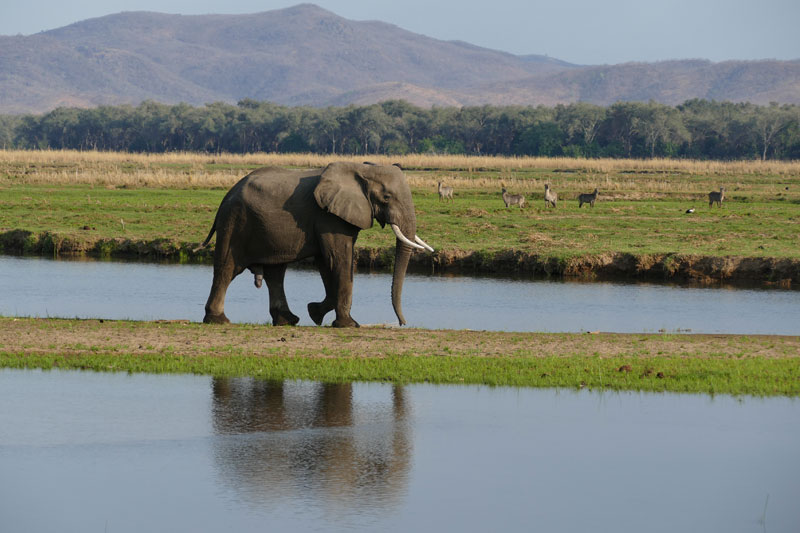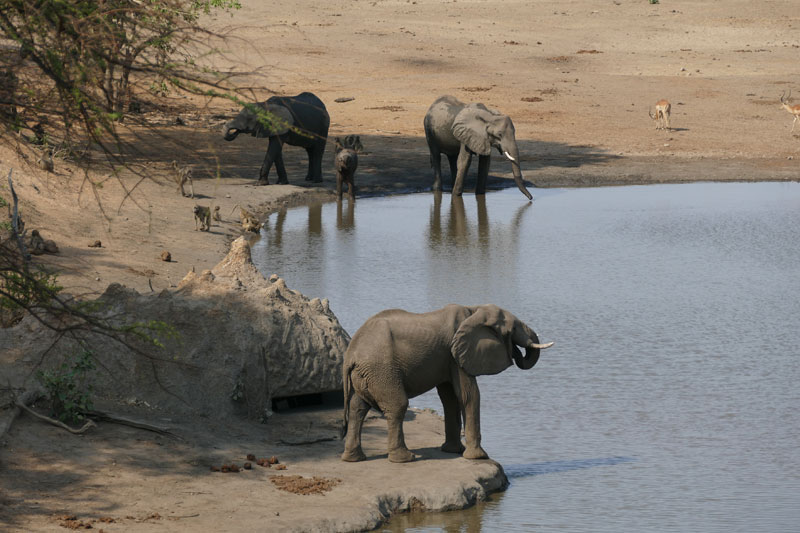As the temperatures dropped in UK, I headed out to Zimbabwe where they had just recorded some of their highest temperatures on record, some 47 degrees! It is the end of a long dry season in Zimbabwe and as I bounce around in the thermals flying north from Harare to the beautiful Mana Pools National Park, I look down on a parched brown landscape beneath. I have heard they are feeding animals in Mana for the first time in many years and wonder just how bad things could be for the wildlife.



My first stop was a new lodge in the south-west corner the park, away from the Zambezi at the foot of the escarpment. Kavinga Safari Camp is built on a small ridge overlooking a natural spring which is supplemented by solar pumped water. As the only water source for many miles around, this pan is extremely active, especially at the end of the dry season from September to November. Whilst the lodge itself was very pleasant and I was well looked after, it is the pan and underground hide (built into a termite mound at the water’s edge) that really provided the unique experience. Lion, leopard, elephant, buffalo, wild dogs, eland, kudu, baboons and the rest……….the action was non-stop and I have created a short film on my dramatic experience in the hide.
I then moved down to the waterfront region of the park, known for its beautiful floodplain and open woodlands. Moving west to east I stayed at several new camps and visited all our established partners. At both Camp Mana and John’s Camp I enjoyed a very exclusive camp experience hosted by professional guides. Both camps offer a quiet, close to nature experience with walking a key feature. Mana is known for its wild dog (painted wolves) population and for its very relaxed big bull elephants, both of which are unperturbed by approaches on foot. Indeed we found the dogs and were able to watch them at close quarters as they awoke from their daytime resting. It is an incredible experience, but be warned that in high season you are unlikely to be alone.
My last two nights were spent at Chikwenya and Sapi Explorers in the Sapi Wilderness which borders the eastern side of the park. Formerly a hunting concession, Sapi offers a more exclusive game viewing experience, including boat cruises, and I loved getting out on the river in the afternoons. Sunset on the Zambezi, with elephants silhouetted against the red sky, hippos grunting and flocks of storks flying overhead, is magical. On one occasion we took rods and tried some fishing, with one guest hauling in a huge 13 pound tiger after just 15 minutes!
Mana Pools is one of Africa’s iconic parks, but this year it is extremely dry. We spoke to many guides about the feeding program that has been necessary to sustain the grazers, yet we still witnessed the struggle first hand. On one morning we passed a young elephant lying on the ground with its mum close by. It raised its head and trunk weakly as we passed. 2 hours later it remained motionless as we passed again, a vivid reminder of the daily battle until the rains arrive.



From Mana Pools I headed south by air, calling in to see the Save Valley Conservancy and Malilangwe Wildlife Conservancy en route to Gonarezhou National Park. These regions make up what is known as the south-eastern lowveld region of Zimbabwe.
Save Valley is a vast wilderness area made up of privately owned ranches that was poised to develop as a photographic safari area just before the land use troubles kicked off in 2000. Since then it has been worked predominantly as a hunting area but a couple of ranches are now setting aside land for photographic purposes, with aim to ultimately convert the entire area over the coming years. It is a huge conservation initiative, and complicated by politics, but eventually we should see Save Valley emerge as an excellent and exclusive big game region. For now, those who visit are ensured an incredibly exclusive experience, with flexible activities centred around walking, interesting birding and plenty of big game including predators such as wild dogs which have been studied there for many years.
Malilangwe is far easier to sum up – a private game conservancy boasting a super luxury lodge called Singita Pamushana. Capable of comparison to the top lodges around Africa, Pamushana offers excellent big game viewing in combination with a stunning hilltop setting (overlooking a large lake). Most of the guests fly in from Johannesburg and see very little of Zimbabwe – this is either very convenient or a shame depending on your time-frame and viewpoint.



The real focus of my visit this region, however, was to explore Gonarezhou National Park, and over the course of 3 nights I came to really appreciate what the park has to offer. To my mind it is comparable to many of the great parks of Africa, and should certainly be talked about in the same breath as Hwange and Mana Pools, Zimbabwe’s premier game viewing destinations. It is both beautiful and varied in terms of scenery, and boasts fantastic game viewing, from large elephant and buffalo herds to the full range of major predators (lion, leopard, wild dogs, cheetah and hyaena). Bird life is also prolific, enhanced by the different ecosystems in the park, from riverine forest and wetlands to mopane woodland, granite hills and Cretaceous sand veld. I was in fact so enthused by this exclusive and wild park that we are featuring it on our website and in our annual newsletter.
My visit included a night at the lovely Chilo Gorge Safari Lodge, followed by two nights camping on their Ivory Trail safari. Chilo has a spectacular location on the Save River with access to some of the best game viewing areas in the park. However it was the Ivory Trail camping that I really loved. Old school camps, where it feels like you are the only people in the park, totally surrounded by nature. A small friendly team provided warm water when needed and delicious meals. In the evening we sat around the camp fire and listened to rival lion prides claiming their ground. We picked out nightjars and Scops owl calling close by, whilst at 03h00 one night the resident Impala herd alerted us to the presence of a predator. My money was on a leopard, of which there are plenty, but our early morning drive revealed lion tracks. One afternoon we drove up onto a vast sandstone massif, and sat spellbound on top of the famous Chilojo Cliffs, watching elephants in the Runde River far below. On the way down we surprised a lone cheetah that showed us a turn of speed as it put some distance between us. The animals of Gonarezhou are not habituated to humans and vehicles like in many places, so this is genuine wild Africa still. I was hosted by Clive Stockil, an ardent conservationist and safari operator who has spent his entire life in Zimbabwe’s lowveld. He was a fountain of knowledge on the park, and remarkable at identifying birds, and is available to guide private safaris for anyone interested in that extra level of history, geology and conservation. All in all, a hugely successful and rewarding visit and I would highly recommend Gonarezhou to anyone seeking a little adventure and exclusivity combined with beautiful scenery, great game viewing and interesting birding.



After a short stop in Masvingo, where I wanted to see the marvellous Great Zimbabwe Ruins (well worth a visit for anyone travelling through the country and specifically with interests in culture, history and archaeology) and have some lunch at Norma Jeanes, an old school country hotel overlooking Lake Kyle, my final destination in Zimbabwe was the Matobo Hills National Park, close to Bulawayo.
Known for its rock art, rhino conservation and for being home to the resting place of Cecil Rhodes, Matobo Hills also offer beautiful granite scenery and excellent birding. I enjoyed an excellent morning rhino walk, where we tracked a mother and calf white rhino, and I thoroughly enjoyed visiting World’s View, where Rhodes is buried into the top of a granite hill. The scenery was magical and hearing about the history of the region was enthralling. The Matobo Hills do not offer traditional big game viewing, but they offer a rewarding mix of culture, scenery, birds and game, which very much compliments the more game intensive regions of Zimbabwe. In particular, it is only a 4 hour drive from Matobo Hills to Hwange National Park, and a further 2 hours to Victoria Falls, so combining these three regions is a natural option to consider.



Rob visited Kavinga Safari Camp, Kanga Camp, Goliath Camp, Camp Mana, Little Ruckomechi, Ruckomechi Camp, Little Vundu, Vundu Camp, Zambezi Expeditions, John’s Camp, Nyamatusi Camp and Nyamatusi Mahogany, Chikwenya, Sapi Explorers Camp, Sango Safari Lodge and Tented Camp, Singita Pamushana, Chilo Gorge Safari Lodge, Chilo Tented Camp, Chilo Ivory Trail, Norma Jeanes, Big Cave Camp and Amalinda Lodge.
